
Concept explainers
Interpretation: The resonance structure of the PO2F2 − ion should be drawn.
Concept Introduction:
- Sometimes the chemical bonding of a molecule cannot be represented using a single Lewis structure. In these cases, the chemical bonding are described by delocalization of electrons and is known as resonance.
- All the possible resonance structures are imaginary whereas the resonance hybrid is real.
- These structures will differ only in the arrangement of the electrons not in the relative position of the atomic nuclei.
To find: The resonance structure of PO2F2 − ion
Answer to Problem 6.62QP
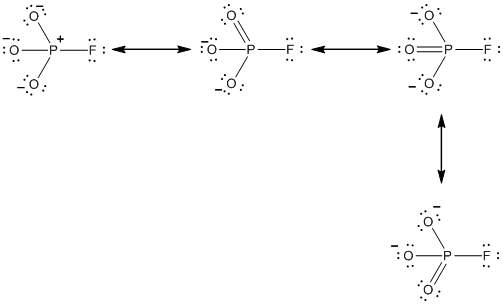
Explanation of Solution
Resonance structure of PO2F2 − ion is drawn below.
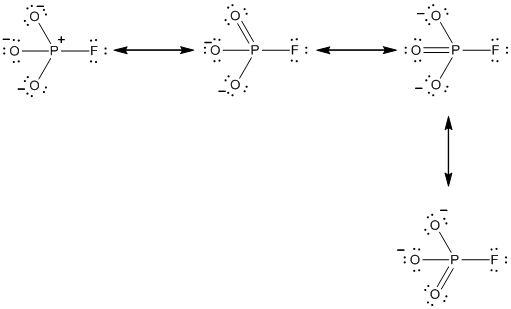
In the case of PO2F2 −, the chemical bonding of a molecule cannot be represented using a single Lewis structure. The chemical bonding are described by delocalization of electrons forming 4 possible resonance structures. In all the 4 resonance structures the position, over whole charge and chemical framework remains intact.
The resonance structures of the PO2F2 − ion were drawn.
Interpretation: The formal charges of the PO2F2 − ion should be drawn.
Concept Introduction
- A formal charge (FC) is the charge assigned to an atom in a molecule, irrespective of relative electronegativity by thinking that electrons in all
chemical bonds are shared equally among atoms. - This method is used to identify the most probable Lewis structures if more than one possibility exists for a compound.
- Formal charge of an atom can be determined by the given formula.
Formal charge (F C) = (no.of valence electron in atom)−12(no.of bonding electrons)−(no.of non-bonding electrons)
Answer to Problem 6.62QP
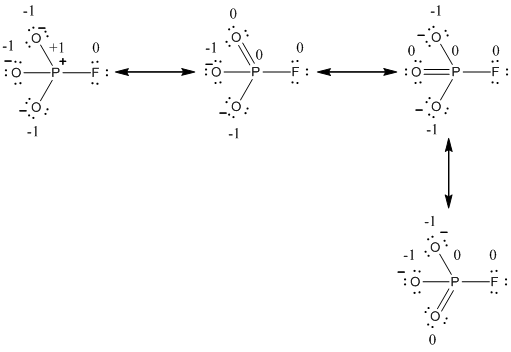
Explanation of Solution
The formal charge of the given resonance structure is given below.
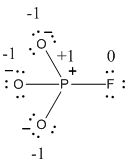
The formal charge of the given resonance structure is calculated,
- Phosphorous atom
Number of valence electron=5Number of bonding electron= 8Number of non-bonding electron = 0
Substituting these values to the equation,
FC = 5− (12×8)= +1
- Oxygen atom (a)
Number of valence electron=6Number of bonding electron= 2Number of non-bonding electron = 6
Substituting these values to the equation,
FC = 6− (12×2)−6= −1
- Oxygen atom (b)
Number of valence electron=6Number of bonding electron= 2Number of non-bonding electron = 6
Substituting these values to the equation,
FC = 6− (12×2)−6= −1
- Oxygen atom (c)
Number of valence electron=6Number of bonding electron= 2Number of non-bonding electron = 6
Substituting these values to the equation,
FC = 6− (12×2)−6= −1
- Fluorine atom
Number of valence electron=7Number of bonding electron= 2Number of non-bonding electron = 6
Substituting these values to the equation,
FC = 7−(12×2) −6= 0
The formal charge of the given resonance structure is given below.
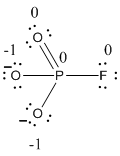
The formal charge of the given resonance structure is calculated,
- Phosphorous atom
Number of valence electron=5Number of bonding electron= 10Number of non-bonding electron = 0
Substituting these values to the equation,
FC = 5− (12×10)= 0
- Oxygen atom (a)
Number of valence electron=6Number of bonding electron= 4Number of non-bonding electron = 4
Substituting these values to the equation,
FC = 6− (12×4)−4= 0
- Oxygen atom (b)
Number of valence electron=6Number of bonding electron= 2Number of non-bonding electron = 6
Substituting these values to the equation,
FC = 6− (12×2)−6= −1
- Oxygen atom (c)
Number of valence electron=6Number of bonding electron= 2Number of non-bonding electron = 6
Substituting these values to the equation,
FC = 6− (12×2)−6= −1
- Fluorine atom
Number of valence electron=7Number of bonding electron= 2Number of non-bonding electron = 6
Substituting these values to the equation,
FC = 7−(12×2) −6= 0
The formal charge of the given resonance structure is given below.

The formal charge of the given resonance structure is calculated,
- Phosphorous atom
Number of valence electron=5Number of bonding electron= 10Number of non-bonding electron = 0
Substituting these values to the equation,
FC = 5− (12×10)= 0
- Oxygen atom (a)
Number of valence electron=6Number of bonding electron= 2Number of non-bonding electron = 6
Substituting these values to the equation,
FC = 6− (12×2)−6= −1
- Oxygen atom (b)
Number of valence electron=6Number of bonding electron= 4Number of non-bonding electron = 4
Substituting these values to the equation,
FC = 6− (12×4)−4= 0
- Oxygen atom (c)
Number of valence electron=6Number of bonding electron= 2Number of non-bonding electron = 6
Substituting these values to the equation,
FC = 6− (12×2)−6= −1
- Fluorine atom
Number of valence electron=7Number of bonding electron= 2Number of non-bonding electron = 6
Substituting these values to the equation,
FC = 7−(12×2) −6= 0
The formal charge of the given resonance structure is given below.
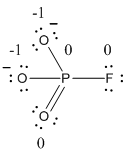
The formal charge of the given resonance structure is calculated,
- Phosphorous atom
Number of valence electron=5Number of bonding electron= 10Number of non-bonding electron = 0
Substituting these values to the equation,
FC = 5− (12×10)= 0
- Oxygen atom (a)
Number of valence electron=6Number of bonding electron= 2Number of non-bonding electron = 6
Substituting these values to the equation,
FC = 6− (12×2)−6= −1
- Oxygen atom (b)
Number of valence electron=6Number of bonding electron= 2Number of non-bonding electron = 6
Substituting these values to the equation,
FC = 6− (12×2)−6= −1
- Oxygen atom (c)
Number of valence electron=6Number of bonding electron= 4Number of non-bonding electron = 4
Substituting these values to the equation,
FC = 6− (12×4)−4= 0
- Fluorine atom
Number of valence electron=7Number of bonding electron= 2Number of non-bonding electron = 6
Substituting these values to the equation,
FC = 7−(12×2) −6= 0
The formal charge of the PO2F2 − ion was found.
Want to see more full solutions like this?
Chapter 6 Solutions
Chemistry Atoms First, Second Edition
- 23.34 Show how to convert each starting material into isobutylamine in good yield. ཅ ནད ཀྱི (b) Br OEt (c) (d) (e) (f) Harrow_forwardPlease help me Please use https://app.molview.com/ to draw this. I tried, but I couldn't figure out how to do it.arrow_forwardPropose a synthesis of 1-butanamine from the following: (a) a chloroalkane of three carbons (b) a chloroalkane of four carbonsarrow_forward
- Select the stronger base from each pair of compounds. (a) H₂CNH₂ or EtzN (b) CI or NH2 NH2 (c) .Q or EtzN (d) or (e) N or (f) H or Harrow_forward4. Provide a clear arrow-pushing mechanism for each of the following reactions. Do not skip proton transfers, do not combine steps, and make sure your arrows are clear enough to be interpreted without ambiguity. a. 2. 1. LDA 3. H3O+ HOarrow_forwardb. H3C CH3 H3O+ ✓ H OHarrow_forward
- 2. Provide reagents/conditions to accomplish the following syntheses. More than one step is required in some cases. a. CH3arrow_forwardIdentify and provide an explanation that distinguishes a qualitative and quantitative chemical analysis. Provide examples.arrow_forwardIdentify and provide an explanation of the operational principles behind a Atomic Absorption Spectrometer (AAS). List the steps involved.arrow_forward
- Instructions: Complete the questions in the space provided. Show all your work 1. You are trying to determine the rate law expression for a reaction that you are completing at 25°C. You measure the initial reaction rate and the starting concentrations of the reactions for 4 trials. BrO³¯ (aq) + 5Br¯ (aq) + 6H* (aq) → 3Br₂ (l) + 3H2O (l) Initial rate Trial [BrO3] [H*] [Br] (mol/L) (mol/L) | (mol/L) (mol/L.s) 1 0.10 0.10 0.10 8.0 2 0.20 0.10 0.10 16 3 0.10 0.20 0.10 16 4 0.10 0.10 0.20 32 a. Based on the above data what is the rate law expression? b. Solve for the value of k (make sure to include proper units) 2. The proposed reaction mechanism is as follows: i. ii. BrО¸¯ (aq) + H+ (aq) → HBrO3 (aq) HBrO³ (aq) + H* (aq) → H₂BrO3* (aq) iii. H₂BrO³* (aq) + Br¯ (aq) → Br₂O₂ (aq) + H2O (l) [Fast] [Medium] [Slow] iv. Br₂O₂ (aq) + 4H*(aq) + 4Br(aq) → 3Br₂ (l) + H2O (l) [Fast] Evaluate the validity of this proposed reaction. Justify your answer.arrow_forwardе. Д CH3 D*, D20arrow_forwardC. NaOMe, Br Brarrow_forward
 Chemistry: Principles and PracticeChemistryISBN:9780534420123Author:Daniel L. Reger, Scott R. Goode, David W. Ball, Edward MercerPublisher:Cengage Learning
Chemistry: Principles and PracticeChemistryISBN:9780534420123Author:Daniel L. Reger, Scott R. Goode, David W. Ball, Edward MercerPublisher:Cengage Learning Chemistry: Principles and ReactionsChemistryISBN:9781305079373Author:William L. Masterton, Cecile N. HurleyPublisher:Cengage Learning
Chemistry: Principles and ReactionsChemistryISBN:9781305079373Author:William L. Masterton, Cecile N. HurleyPublisher:Cengage Learning Chemistry: The Molecular ScienceChemistryISBN:9781285199047Author:John W. Moore, Conrad L. StanitskiPublisher:Cengage Learning
Chemistry: The Molecular ScienceChemistryISBN:9781285199047Author:John W. Moore, Conrad L. StanitskiPublisher:Cengage Learning


